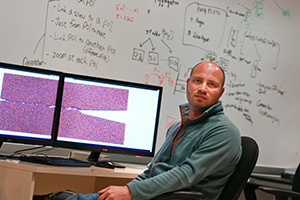Thanks to the University of Utah’s rising reputation for computer science research and its work on computer simulations and visualization, a center with the university’s Scientific Computing and Imaging Institute (SCI) was named an Intel Parallel Computing Center (IPCC), an honor bestowed on institutions that are leaders in the field of high-performance computing.

The Center for Extreme Data Management Analysis and Visualization (CEDMAV), which is a center in SCI, was awarded $300,000 over two years as well as free Intel hardware to help with the university’s research. Other institutions that have been named Intel Parallel Computing Centers include some at Stanford, Georgia Tech, Johns Hopkins, and the University of Texas at Austin.
“The IPCC program was competitive and we are proud to join this effort,” says SCI Institute research scientist, Aaron Knoll, who applied for the grant. “The University of Utah and the SCI Institute have a long history of doing pioneering graphics and visualization work on cutting-edge hardware.”
Knoll plans to use the money to help with his research, which includes work on visualizing materials and quantum chemistry simulations in high performance computing environments. One of his goals is to help research new materials that can produce better batteries. In order to do that kind of work, researchers need high-powered computers that can perform dense calculations at high speed as well as be an effective means of visualizing and analyzing their data. He says Intel’s new hardware and the research supported by this grant can help achieve those goals.
“Scientific data are becoming much larger and simulations are still running on predominately-CPU supercomputing resources,” Knoll says. “We would like to have ways of doing larger-scale visualization without moving data and taking advantage of the underlying hardware.”
CEDMAV focuses on research with extreme data, including climate modeling, astrophysics and medical imaging.